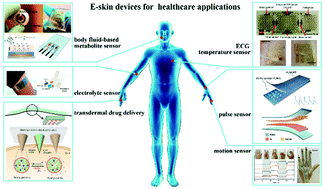Our great stroke association (If we had one) would be setting up all kinds of applications for this; blood oxygen, blood pressure, pulse, body temperature, listening for atrial fibrillation, listening in on carotid arteries for plaque and much more.
Advanced electronic skin devices for healthcare applications
Abstract
Electronic skin, a kind of flexible electronic device and system inspired by human skin, has emerged as a promising candidate for wearable personal healthcare applications. Wearable electronic devices with skin-like properties will provide platforms for continuous and real-time monitoring of human physiological signals such as tissue pressure, body motion, temperature, metabolites, electrolyte balance, and disease-related biomarkers. Transdermal drug delivery devices can also be integrated into electronic skin to enhance its non-invasive, real-time dynamic therapy functions. This review summarizes the recent progress in electronic skin devices for applications in human health monitoring and therapy systems as well as several potential mass production technologies such as inkjet printing and 3D printing. The opportunities and challenges in broadening the applications of electronic skin devices in practical healthcare are also discussed.

- This article is part of the themed collection: Recent Review Articles

Dean, during the pandemic, our son started working for Whoop, which makes a fitness band. It measures (or reports on) HR, R-R variability (and, so, atrial fib, although it doesn't make that claim; it uses HRV to indicate fitness), blood oxygen (a little low, I find), body temp and sleep patterns. Although it's designed for serious athletes (QB Patrick Mahomes wears one), I wear it anyway, and the data is interesting. I think you would too. I find that hiking in our woods is my most strenuous exercise, more than my sessions swimming, which are the hardest for me, or biking, which is God-awful boring!
ReplyDelete